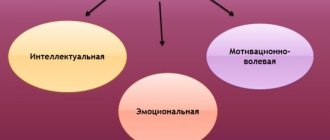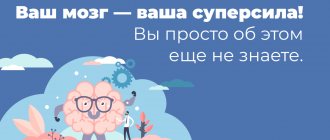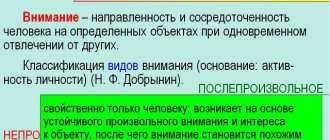In this article we will tell you:
- Basic properties of attention
- Dependence of attention on the type of temperament
- Signs of trouble focusing
- Main causes of absent-mindedness
- Ways to increase focus
Imagine: you have been given an assignment that needs to be completed quickly and efficiently; for this you need to mobilize all your strength, tune in and concentrate. But there is a problem with this point. You may be distracted by someone or you may be preparing for a long time, thinking through the task down to the smallest detail. Have you ever found yourself in a similar situation? It probably doesn’t cause the most pleasant feelings, because in the end you are forced to postpone the assigned task, which gives rise to dissatisfaction with yourself.
Don’t be upset, this happens to everyone, it’s just that some people don’t talk about it, not considering it a problem. You can control your level of concentration and always do your job perfectly at the right time! And today we will talk about what focus is and how to develop the habit of concentrating on the primary task.
Make your workplace comfortable and keep it in order
When it is comfortable to work at a desk, your productivity increases. Concentrating on tasks is much more difficult if the table is cluttered, the chair is uncomfortable, the light from the lamp is annoying, and the room is stuffy or cold. Therefore, you need to fix the things in your room that make you uncomfortable studying, and learn to maintain constant order. If on your desk there are only those textbooks, notebooks and printouts that are needed at the moment, you will not have to waste extra energy looking for the right thing.
Guide to Developing Concentration
Some abilities require months of practice to achieve any noticeable improvement. There is not always time for this and often there is not enough desire. But it only takes a few days to improve your concentration. In general, this is a very ironic skill: improving it will require... concentration. Not only, of course, you also need motivation, enthusiasm and patience.
What does concentration consist of?
Bill Gates called concentration the most important quality that every person should develop. One cannot but agree with him, because concentration is closely related to attention and memory, developed intellect and thinking (including creative). Thus, we can say that if you know how to concentrate, then you are an intelligent person and are able to notice and remember a lot of things.
Concentration is in one way or another connected with all the skills that a person engaged in self-development seeks to develop. Do you want to write a novel, a painting, a song? It is difficult to create without the ability to concentrate. Do you want to become a master of communication, speak in front of the public with a speech memorized, and not forget anything? Train your memory, be attentive and don’t be distracted by anything.
What does this mean for you and me? Only one thing: concentration can be improved by developing attention, memory, creative thinking and intelligence. And vice versa. So let's find out how you can improve your concentration. We'll give you a few tips, then a dozen exercises, and then we'll talk about the most interesting training apps for your phone and computer. All together will give an excellent result.
How to develop concentration
The development of concentration occurs in two ways: the exclusion of external stimuli and special exercises that help purposefully train the skill.
1
Remove all irritants
This is the first thing to do. You can practice as much as you like, but if the environment gets in the way, it won't be of much use. Find yourself a quiet place or eliminate irritants.
Also, use earplugs or headphones. Seriously, this helps a lot, especially in the early stages. When your level of concentration increases significantly, you can do without them - you can read a book or write an article on public transport or in a cafe.
2
Notice
Keep small cards 3 by 5 cm. Every time your mind starts to wander while reading or working, mark it on them. It is important to divide them into three colors and times of day: morning, afternoon and evening (green, red and yellow). After a few days, you'll find that this simple trick helps you feel less distracted.
Recognizing the problem is the first step, so this method teaches you to pay attention to it. This allows you to increase your concentration levels without making much effort, just by reminding yourself to stay focused. Using this method, you will also be able to see what time of day is more or less productive, you will understand how the level of concentration decreases after a meal, a quarrel, and how it increases after a walk and a light snack.
3
Use the spider technique
What will a spider do if you quietly hit a tuning fork not far from its web? He will get out to see what happened, his curiosity will be piqued. But if you repeat this trick several times, the spider will no longer respond to sounds. He knows what to expect, so he ignores them.
What does all of this mean? Expect distractions and try not to react to outside sounds. A door slams, a bird whistles, a neighbor knocks from upstairs - whatever the stimulus, continue to focus on your task. Surprisingly, after a while you simply stop being aware of and responding to the sounds around you.
4
Eat foods that are good for concentration
This may not seem important, but the physiological side should not be ignored.
Blueberry . Contains many natural antioxidants that increase blood flow and brain activity.
Green tea . It contains not only caffeine, but also, more importantly, large amounts of L-Theanine.
Greenery . Chlorophyll contains many carotenoids, which increase blood flow, as well as B vitamins, which enhance memory.
Fatty fish . Fish, such as salmon and cod, are loaded with Omega-3 fatty acids, which are good for the brain.
5
Stay in a conscious state
This advice is heard very often in the literature on self-development, but what can you do - this ability solves a huge number of problems. Mindfulness is the ability to notice. Moreover, notice not only the world around you, but also internal processes. This means that you can control your attention and concentration if you are aware.
Practice meditation for about 20 minutes a day. This is the required minimum. In addition, it is advisable to find other opportunities to remain in a conscious state throughout the day. The simplest and most effective way: focus completely on what you are doing. Eat - fully enjoy the process of eating food. When you wash dishes, think only about them and your washing technique. Not only will the most routine processes allow you to enjoy yourself, but you will also be able to increase both the level of awareness and the level of concentration!
It's extremely difficult. Sometimes you will be angry with yourself for forgetting about the present. But don’t panic: now you have remembered this, you are “here and now.” Every week you will increase the amount of time you spend consciously.
Now let's move on to the practical part. Here we need great patience and desire.
Exercises to develop concentration
The unique thing about almost all concentration exercises is their simplicity. There is no need to invent anything complicated if you can focus on one thing and improve your level.
Inspirational word
Pick one inspiring word and think about it, repeating it in your head for five minutes.
Word count
Take a book or magazine and count the number of words in one paragraph. Count them again to make sure you didn't make a mistake the first time. You can start with one paragraph, and as you get used to it, move on to counting words in two paragraphs.
Then move on to counting words on the entire page. Make sure you count mentally and only with your eyes, without pointing your finger at each word. This is one of the simplest but most effective exercises for improving concentration.
Countdown
Subtract from 1000 one unit at a time in your head. If it's too easy, subtract 2, 7, 9, any higher number.
Thought suppression
Try to suppress your thoughts for 5 minutes. It's quite difficult, but with regular practice you can do it. Start with one minute and gradually increase the time.
Inspection of the item
Take a fruit, such as an apple, banana or orange, in your hand and examine it from all sides, focusing your full attention. At the same time, try to keep it stable in one position. Do this for one minute and then gradually increase to five. Change hands.
Without words
Take a small, simple object such as a spoon, fork, cup or glass. Now focus on it, observing it from all sides without verbalization, that is, without words in your mind. Just focus on watching the object closely without thinking about it.
Motionless
Sit in a comfortable chair and see how long you can stay in place. It may seem easy, but it only seems so until you try. All you have to do is focus your attention on sitting. Make sure you do not make any involuntary muscle movements. With practice, you can sit without moving your muscles for 15 minutes.
Concentration from within
This exercise will allow you to focus from within. Start by lightly relaxing your muscles. Now focus on your heartbeat without paying attention to anything else. Think about your heart and how it pumps blood to every part of your body. As you do this, try to “see” the blood leaving your heart and follow it as it flows in one stream straight to your toes.
Deep breathing
Sit on a chair in an upright position, keeping your back high. Now, pressing one finger to your right nostril, take a deep, deep breath. Breathe calmly, count to ten, then push the air out. Repeat this exercise with the other nostril. Exercise 20 times a day.
Sounds
This exercise is about focusing on sounds. In everyday life we are surrounded by a large number of them. Try to focus on a specific sound, such as a voice or rustling sound. Then deliberately switch to something else, such as a bird.
Switch to the next one, say the sound of traffic. Continue switching between sounds after focusing on one for one minute.
This exercise can also be made visual by focusing on the person or thing that is making the sound and refocusing on another.
Drawing and coloring
Drawing and coloring are great activities for relaxing the brain and stimulating creativity. It also improves concentration.
Small victories
The good thing about this exercise is that it encourages you to use everyday tasks to train your concentration. Choose an activity, such as finding clients, writing a poem, reading a chapter of a book, and set a timer. 5 to 10 minutes is best. During this time, nothing in this world should exist except you and your task. Turn off your phone and close the door. Try to increase the exercise to 90 minutes. If you practice regularly, you can reach this number in a month.
Motivation of mirrors
The most beneficial form of concentration is making eye contact with another person and perceiving a deeper connection. Stand in front of a mirror and place two stickers at eye level. Imagine these are the eyes of your interlocutor. All your thoughts should be focused on keeping your head completely still and avoiding other thoughts. Breathe deeply. Completion time is five minutes.
Concentration apps
Brain Focus Productivity Timer
This free Android app is designed to help you manage your time. It allows you to set the number of minutes you want to work for and then take a scheduled break. The idea is taken from the Pomodoro technique, that is, you set 25 working minutes and then rest for 5. The process is repeated over and over again.
This way, you will be much more productive instead of forcing yourself to work for hours without taking a break. Brain Focus is easy to use and shows how productive you are.
(OFFTIME)
It is also a free app on Android. Offtime allows you to disconnect from the outside world without missing anything urgent. You can block distractions such as apps, calls and messages, but whitelist those who will be able to contact you anyway.
The app can also automatically respond to messages on your behalf, as well as keep track of what you missed while you were away. Offtime provides information about your phone usage and the hours you spend each day, highlighting which apps are taking up the most of your time.
Forest
The application for iOS and Android, paid, costs about two dollars. It is considered one of the most popular.
Improve performance by placing virtual trees in Forest. Whenever you want to focus on a task, open the app and plant a tree. If you don't stop for 30 minutes, you will see it grow. This way you will create a whole forest. If you fail, the tree will die.
NOISLI
This is a free online platform. Use Noisli to help you create the perfect atmosphere. This is a white noise app that can be used to mix different natural sounds, such as the sound of a train or a crackling fire.
Noisly is ideal for people who can't handle music but want some noise in the background.
Books
Considering that concentration is the ability to focus on one thing for a long time, reading books itself can be an excellent workout. And if you read books on this topic, the benefits will be double. Here's where you can start.
- “The art of concentration. How to improve your memory in 10 days" Eberhard Heul
- “The Japanese System for the Development of Intelligence and Memory” by Ryuta Kawashima
- "A Guide to Memory and Intelligence" by Tony Buzan
- "Focus. On attention, distraction and success in life" Daniel Goleman
- “Maximum concentration. How to Stay Effective in the Age of Clip Thinking by Lucy Jo Palladino
- “Don't distract me. How to Stay Focused No Matter What Edward Hallowell
- “The four-second rule. Stop. Think about it. Do it" Peter Bregman
- "The Power of Concentration" William Walker Atkinson
- “Time management by pomodoro. How to concentrate on one thing for at least 25 minutes" Staffan Neteberg
In conclusion, a short video about attention and the ability to concentrate:
We also recommend reading:
- Storytelling
- How books make us better people
- Mindful Habits to Create Power of Concentration and Focus
- Simple ways to increase concentration
- Concentration: exercises
- Five-minute exercises to improve concentration
- 6 rules for brain development
- The Power of Deep Thinking
- How to develop attention
- 7 ways to become more focused
- What are cognitive abilities
Key words:1Psychoregulation
Nutrition and daily routine
- Research has shown that the ability to concentrate is highly dependent on rest. If you feel tired, your thinking will be distracted. Go to bed and get up at the same time, rest for 7-8 hours every day (but don’t oversleep on the weekends - this will disrupt your biorhythm and make you lazy).
- Review your daily diet. Nutrition should be balanced. Frequent overeating will make you feel sleepy and sluggish. Healthy food (protein from lean meat, fish, dairy products, freshly squeezed juices) together with good sleep improves the ability to concentrate.
- Provide your body with oxygen. Most of the blood that carries oxygen is in the lower part of the body, not reaching the brain, and it becomes more difficult to concentrate. To solve this problem, leave your work area more often, stretch your legs, and walk more. Do a couple of simple exercises. Regularly ventilate the room you are in.
- The state of health largely determines the ability to concentrate. With constant fatigue, illness and discomfort, it will be difficult to concentrate. Get regular medical examinations, take a course of vitamins and exercise - for example, jog in the morning or sign up for a swimming pool.
How to concentrate? 7 conditions that contribute to achieving this goal
In order to achieve maximum results in the ability to concentrate, you need to prepare and ensure the presence of the following conditions:
- Take care of yourself. This includes a balanced diet that takes into account the nutritional needs of the brain; reasonable physical activity that will ensure blood circulation and nutrition of the brain; adequate sleep and relaxation (relieving stress - therefore, improving the ability to concentrate).
- Minimize all factors that distract you from your work: calls, messages, running TV, and so on. Work on your computer in full screen mode so that unnecessary information does not distract you. Check your email once during the day, at a scheduled time. Ask your loved ones not to disturb you during a certain period of time (do not call, do not interfere).
- Find your motivation, your personal interest to solve any problem.
- Remember that in order to complete a task, you must ensure that you have an appropriate knowledge base.
- Throw away all emotions, forget about everything except the current task.
- Believe in yourself and start taking action.
- Use exercises and games to improve your ability to concentrate.
Little exam
There are several ways to practice listening skills. One of them was mentioned above. In a random set of words, try to highlight the one you need, the characteristic of which will be named by your interlocutor.
Give yourself a little exam. Try to listen carefully to the radio program with your partner and highlight those provisions that you remember. Compare with what your partner heard. As you listen, try turning off your other senses. Focus only on what you hear. Learn to understand and accept the point of view of your interlocutor, which is opposite to yours. Try to say the most important thing you hear to yourself several times.
Signs of trouble focusing
Typically people encounter the following difficulties:
- inability to do one thing for a long time;
- forgetfulness – meetings, agreements, household chores are not remembered; a student may accidentally leave textbooks or notebooks at home;
- tendency to often lose small things, for example, a wallet, keys, glasses;
- the appearance of errors in work - even if a person knows the material well, this does not prevent him from writing down the wrong data, missing important conditions, confusing letters in words, etc.
How our brain works
The mind does not know how to function in several different directions in parallel. At the same time, thoughts wander in your head all the time, which is why you have difficulty concentrating.
When a new task appears, at the very beginning of its implementation, brain activity is aimed at creating neural connections. The more complex the question, the longer this process takes. Within a few minutes, most of the necessary neurons are activated, so it becomes easier to concentrate.
How does concentration happen?
Any business can be divided into 3 stages:
- Turn on (0–15 min.). This is the most energy-consuming stage.
- Productivity phase (20 minutes - several hours).
- Fatigue (decreased performance). Time to take a break.
So, every time you are distracted at the beginning of work, your brain needs to “turn on” again, spending a certain number of minutes on this - you will not be able to immediately concentrate on the goal.
How to learn to concentrate on one thing
The best way to maintain an effective state is to put off all incoming thoughts, tasks, calls, messages until the moment you start to get tired. Then in the third stage you will be able to immediately complete all the additional tasks that have accumulated. This way you will be distracted from the main task, take a little break from it, and switch to other little things.
Main causes of absent-mindedness
Reduced concentration leads to absent-mindedness, which is caused by the following reasons:
- Chronic fatigue.
Overwork, lack of sleep, physical and intellectual stress cause weakening of attention. It is no secret that if you complete tasks with a fresh mind, mistakes are much less common, and fatigue and drowsiness do not allow you to immediately understand what needs to be done.
- Lack of desire to act.
Motivation level is also a factor influencing focus and forgetfulness. When a person on a subconscious level does not want to go somewhere or do a certain job, the brain erases information about the duty from memory, eliminating all problems. It may well be that frequent missed meetings, failure to meet agreements and deadlines are a sign of lack of desire, and not absent-mindedness itself.
- Autopilot program failure.
Everyday activities usually do not require serious thought. People, without hesitation, lock the apartment door, turn off the lights, turn off the boiling kettle, and get ready for school. If any distraction appears at this time, the automatic program will not work. As a result, many people lose things, forget documents on the table, or don’t turn off the iron.
- Too many tasks.
If a person has to do a lot at once and keep it in memory, concentration drops and attention becomes more distracted. As a result, a couple of tasks are forgotten, and the rest are performed poorly. An excess of tasks has a negative impact on the efficiency of any work.
- Lack of attention.
People regardless of age face attention deficit disorder. A side effect is the inability to do one task for a long time.
Doing only one thing at a time
Active people boast the ability to do several things at the same time, considering this property an enviable honor. While multitasking can help one achieve career heights, it makes one prone to making unintentional mistakes. In terms of concentration, multitasting also has major disadvantages. The main negative factor is constant distraction.
In solving the problem of how to learn not to be distracted and concentrate, you need to do tasks one by one, step by step, and determine priorities. The habit of starting with simple tasks and ending with complex things will have to be abandoned. Tasks that require a lot of attention and creativity should be solved first, ideally in the first half of the day, when the brain is still fresh.
At the same time, important, priority tasks should not be left until they become urgent. Otherwise, their implementation puts a lot of pressure, the person is in a state of stress, in which it becomes several times harder to focus attention.
Concentration training for a child
Learning methods to improve concentration is necessary not only for adults, but also for children. This ability is especially important at school, when you need to quickly concentrate on a lesson or when doing homework. For younger children, practicing focusing is a good start to preparation for school life.
Exercises for the little ones:
- Read any story to your child - the baby will receive instructions to clap his hands whenever he hears a certain name or the name of an object.
- Together with your child, look for differences in similar images, and train him to accurately redraw them in accordance with the original drawing.
- Together, create long, colorful, meaningful sentences that you alternate when reciting - each adding one word to the sentence and repeating what was said earlier.
Exercises for older children:
- Write a short text (2-3 paragraphs) in which you make various mistakes. Their complexity should correspond to the age of the child. You can also practice spelling (assuming your child is familiar with it), including dashes and commas between sentences. The goal of the game is to highlight errors and discrepancies in the text.
- The principle of the next method is similar to the first, slightly edited. But in the text, the child looks for incorrect letters and symbols, but words. Use longer text, one page in size. Double the words in sentences. While reading, the child should highlight all meaningless doublings. For example: “I went to school and I met my friend.”
- Write words in which the letters are reversed. The child's task is to decipher the words. To train younger children, use only 3-4 letters (sel - forest, kovl - wolf), for older children you can use longer words (fortekal - potato). In a simpler version, you can store the beginning or ending of a word, which will indicate a possible solution.
- Great for practicing games (checkers, chess). Any board game that requires patience and following the rules will do. Juggling and other similar activities are suitable for physical activity.
Help from psychologist Daria Milai
Sign up for my consultation and I will help you:
- develop the ability to avoid involuntary attention;
- learn to fully control the work process;
- eliminate all obstacles in a timely manner;
- increase productivity indicator;
- plan your time and activities correctly;
- avoid pointless loads.
Exercises
Adults can try different games to improve concentration. There are many different challenging sudokus, crosswords and other logic games. Sometimes it is advisable to set a time limit for solving problems, but it should not be too short so as not to encourage mistakes.
Training for adults:
- On a piece of paper, print the numbers without spaces. Your task is to cross out, for example, all threes, even or odd numbers within a certain time.
- In your head, count from 100 to 1, then vice versa.
- The next lesson is about training your visual perception. Take any object in your hands, look at it for 2 minutes, trying to concentrate only on it, remember the slightest details. Then put the object aside, close your eyes, imagine it, recreate its appearance in your memory (try to do this as carefully as possible).
Mental activities
Attention can be compared to a muscle that is strengthened through training. And, just as there are exercises for the body, there are exercises for improving attention. One way to learn concentration is a simple exercise in which, by comparing almost identical images, you need to find some differences between them. If tasks seem easy, you can make them more difficult by setting a time limit.
The next option is mirror reading or writing. These exercises require constant concentration and provide instant feedback, because when the thought deviates, the direction of the font immediately changes, you make a visible mistake.
Medications
How to increase your concentration? There are several effective pharmaceutical products that have almost no or minor side effects.
- Glycine is a popular drug, especially among students. It relieves stress and increased nervous excitement, improves brain performance.
- Vitrum Memory is recommended to be taken if intellectual abilities and attention deteriorate. This herbal medicine supplies the brain with oxygen, increasing blood circulation in this organ.
- Undevit - a dragee based on a complex of vitamins A, B, C, E, P, produces a versatile effect.
- Aminalon restores nervous processes and removes toxins that form in the brain from the body.
- Bilobil is recommended for insomnia and decreased intelligence, as well as for getting rid of fear and anxiety. The drug improves oxygen supply to the brain.
- Intellan is a herbal preparation useful for depression, decreased intellectual capabilities and forgetfulness.
- Ginkgo biloba is recommended for memory and attention, insomnia and dizziness.
Basic properties of attention
Attention is a psychophysiological process, a state in which the psyche is directed towards certain objects. It characterizes the dynamic features of cognitive activity, expressed in concentration on a relatively small area of external or internal reality. The latter becomes conscious for a certain period of time, drawing upon itself the basic mental and physical forces of the individual.
Attention is understood as the process of conscious or unconscious/semi-conscious selection of information obtained through the senses, and the parallel ignoring of any other information.
When talking about focusing attention, you need to imagine the key properties of attention. These include:
- Sustainability.
- Concentration.
- Switchability.
- Distribution.
- Volume.
Sustained attention is the ability not to be distracted from an object or subject of activity for a long period of time.
Focused attention, from the point of view of psychology, is the varying degrees of a person’s concentration on some objects and distraction from others. The opposite quality is absent-mindedness.
Switchability of attention is a shift in concentration from one object or activity to another. The main property of switchability is the speed with which the subject voluntarily or involuntarily changes the subject of attention.
Distribution of attention is understood as the ability to focus attention over a large space, carrying out different types of activities.
3 important steps
which every woman should go through
Anika Snagovskaya
Author and presenter of women's trainings on harmonizing feminine energy. Master of removing limiting beliefs and master of constellations.
I have prepared three lessons for you that will help you better understand yourself, remove the restrictions that prevent you from feeling loved and living happily.
01
Video lesson with meditation: 5 states of femininity
You will learn about 5 female states that exist in every woman, how they manifest themselves and which archetypes are most manifested in you and which are not developed.
02
Video lesson + meditation: How to let go of past relationships
I’ll tell you what you need to do to free your heart from old feelings and break the energy threads connecting you with your past partner.
03
Audio recording: Neuro-af
Thanks to this neuro-affirmation, you can regain self-love and feel sincere gratitude and happiness for every day.
✕
Top 3 useful materials that will help you know yourself better
And start a new, happy life for yourself.
Video lesson with meditation: 5 states of femininity
Video lesson + meditation: How to let go of past relationships
Audio recording: Neuro-af
Take your gifts!
Attention span is the amount of information that remains paramount for a person in a certain period of time. On average, for people this indicator is at the level of 5–7 units of information.
Micromeditation
Focus on how you feel. Direct your attention to the foot of your right foot, feel the toes, the sole. Feel the contact of your feet with the floor, the sensations that arise from this contact. Focus on your right hand. Feel your fingers, your palm, the surface of your hand, your entire hand. Feel your forearm, elbow. Feel the contact of the armrest of the chair with your hand and the sensation it causes. Feel your left hand in the same way. Feel your lower back, back, contact with the chair. Focus on your face - nose, eyelids, forehead, cheekbones, chin. Feel the touch of air on your face.










